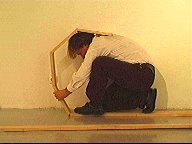
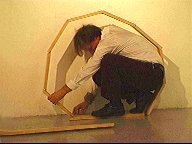
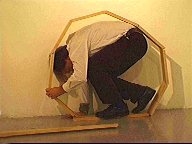
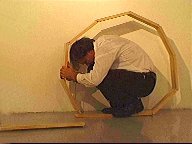
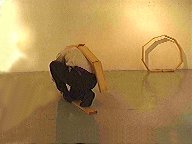
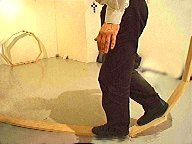
JANUSZ BALDYGA / WIZYA-DONGUY-Paris /






| The Absence in Performance Space I stop at the point around which I construct the order of a performance, resulting from the symmetry of my body. I am aware of the necessity to go on destroying it and the inevitability to recreate it again. This process is ambiguous, full of doubts and resignation, questioning the stability of the resolutions I have accepted. They are essential in creating the dynamic space of a performance or the space for a performance. I cannot see the existence of an absolute boundary between a performance as a gesture and a performance object as a result of this gesture. I can feel clearly a reason for the inevitability of the sequence chaos is. I approach a mistake as a significant factor contributing to the event, not less important than a necessity or relinquishment. An object speaks about the performance, being a result of overcoming inability. In a performance I demonstrate my attitude towards a mistake which without being smoothed over does not influence the essence of the fact. A phenomenon of relinquishment which accompanies it permanently is usually beyond the message as a result of my attention and awareness of a danger caused by unnecessary gestures. A sign of relinquishment is difficult to notice from the outside due to its private, intimate nature. A performer, as somebody who makes - a maker, is situated outside the area of any game, of imitating somebody or even himself. |
| I am a performer, my object is a
consequence of a figure, like its shadow, it happens to
be deformed, elongated. I transfer the symmetry of a
figure to my objects. The use of weight, proportions
derived from a concrete figure gives a probability of
effect. If I face an object with an intention, I know that I have a chance, even if it is challengingly tiny. As somebody, who makes, I would like to confirm an elementary quality of a performance; a performer's presence in the concrete space, facing the concrete audience. A presence realised by its opposite, that is the absence of the expected, is intriguing. Then its prerequisite is a strong signal of the evidence of absence, the pain of absence, the pain of lacking brings to life the opposite notion - a presence which is perceived ambiguously, unaccounted for. It seems that absence as a lack, or in a drastic form a painful lack, can open the field of performer's presence positively. A moment of the first step, crossing over a line beyond which the performance space opens, is intriguing. A performance becomes initiated, a boundary line is crossed over, or paradoxically a performance is started without crossing it. Assuming the absolute uniqueness of a performance as an original gesture one would have to question the credibility of successive expositions of performance objects. But as a consequence of an original gesture it should be a trace revealed only once. The situation I am talking about can be perceived also in a different way, and a performance gesture can be approached as another sequence, another realisation of a concept which has already been realised through the inner projection. It would be possible to move the significance of the first realisation, bringing it closer to an artist in the intimate pre-public area of inner decisions. I disclose the successive significant sequences of my performance publicly. Objects and their successive demonstrations are a natural consequence of adopting a certain notion of the essence of an original. These objects are sequences beyond an original. These objects are exhibited as long as the space 'in between' is the area of decisions, and not the explained and safe vista of communication. Just like in a performance where special presentations exist, eliminating the sense of repetitions and returns. They are positively the last demonstrations, demonstrations of exhaustion. To return does not make any sense, I am bearing this in mind, as each presentation, each demonstration should change my position, constantly establishing my current status. Janusz Baldyga (1997-1999) |